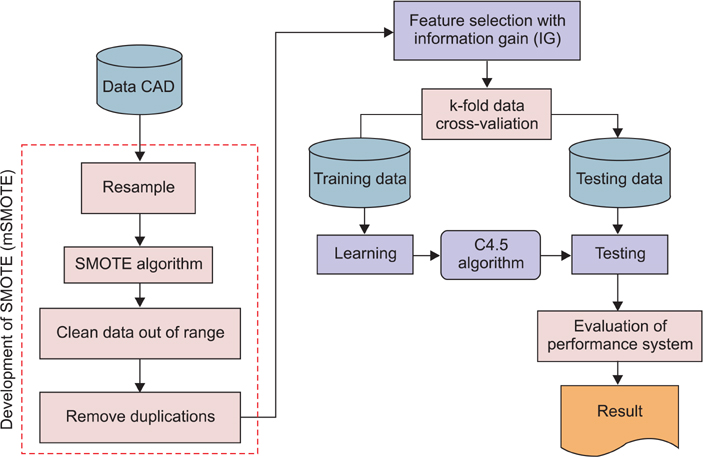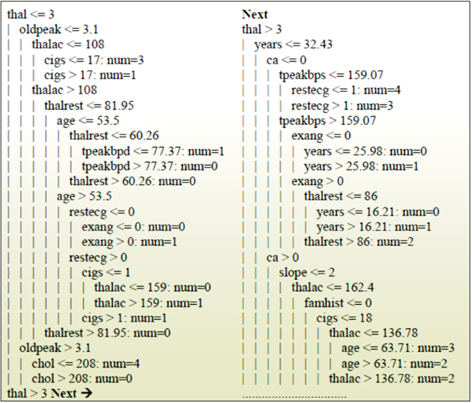Healthc Inform Res.
2016 Jul;22(3):186-195. 10.4258/hir.2016.22.3.186.
Interpretation of Clinical Data Based on C4.5 Algorithm for the Diagnosis of Coronary Heart Disease
- Affiliations
-
- 1Department of Informatic, Sebelas Maret University, Surakarta, Indonesia. wiharto@staff.uns.ac.id
- 2Department of Biomedical Engineering, Gadjah Mada University, Yogyakarta, Indonesia.
- 3Department of Medicine, Gadjah Mada University, Yogyakarta, Indonesia.
- 4Department of Mechanical εt Industrial Engineering, Gadjah Mada University, Yogyakarta, Indonesia.
- KMID: 2357397
- DOI: http://doi.org/10.4258/hir.2016.22.3.186
Abstract
OBJECTIVES
The interpretation of clinical data for the diagnosis of coronary heart disease can be done using algorithms in data mining. Most clinical data interpretation systems for diagnosis developed using data mining algorithms with a black-box approach cannot recognize examination attribute relationships with the incidence of coronary heart disease.
METHODS
This study proposes a system to interpretation clinical examination results for the diagnosis of coronary heart disease based the decision tree algorithm. This system comprises several stages. First, oversampling is carried out by a combination of the synthetic minority oversampling technique (SMOTE), feature selection, and the C4.5 classification algorithm. System testing is done using k-fold cross-validation. The performance parameters are sensitivity, specificity, positive prediction value (PPV), negative prediction value (NPV) and the area under the curve (AUC).
RESULTS
The results showed that the performance of the system has a sensitivity of 74.7%, a specificity of 93.7%, a PPV of 74.2%, an NPV of 93.7%, and an AUC of 84.2%.
CONCLUSIONS
This study demonstrated that, by using C4.5 algorithms, data can be interpreted in the form of a decision tree, to aid the understanding of the clinician. In addition, the proposed system can provide better performance by category.
Keyword
MeSH Terms
Figure
Cited by 1 articles
-
Automatic Glaucoma Detection Method Applying a Statistical Approach to Fundus Images
Anindita Septiarini, Dyna M. Khairina, Awang H. Kridalaksana, Hamdani Hamdani
Healthc Inform Res. 2018;24(1):53-60. doi: 10.4258/hir.2018.24.1.53.
Reference
-
1. Garg AX, Adhikari NK, McDonald H, Rosas-Arellano MP, Devereaux PJ, Beyene J, et al. Effects of computerized clinical decision support systems on practitioner performance and patient outcomes: a systematic review. JAMA. 2005; 293(10):1223–1238.
Article2. Salari N, Shohaimi S, Najafi F, Nallappan M, Karish-narajah I. A novel hybrid classification model of genetic algorithms, modified k-Nearest Neighbor and developed backpropagation neural network. PLoS One. 2014; 9(11):e112987.
Article3. Wiharto W, Kusnanto H, Herianto H. Performance analysis of multiclass support vector machine classification for diagnosis of coronary heart diseases. Int J Comput Sci Appl. 2015; 5(5):27–37.
Article4. Wiharto W, Kusnanto H, Herianto H. Intelligence system for diagnosis level of coronary heart disease with K-star algorithm. Healthc Inform Res. 2016; 22(1):30–38.
Article5. Santhanam T, Ephzibah EP. Heart disease prediction using hybrid genetic fuzzy model. Indian J Sci Technol. 2015; 8(9):797–803.
Article6. Kim J, Lee J, Lee Y. Data-mining-based coronary heart disease risk prediction model using fuzzy logic and decision tree. Healthc Inform Res. 2015; 21(3):167–174.
Article7. Kim JK, Lee JS, Park DK, Lim YS, Lee YH, Jung EY. Adaptive mining prediction model for content recommendation to coronary heart disease patients. Clust Comput. 2014; 17(3):881–891.
Article8. Nahar J, Imam T, Tickle KS, Chen YP. Computational intelligence for heart disease diagnosis: a medical knowledge driven approach. Expert Syst Appl. 2013; 40(1):96–104.
Article9. Prabowo DW, Setiawan NA, Nugroho HA. A study of data randomization on a computer based feature selection for diagnosing coronary artery disease. Adv Intell Syst. 2014; 53:237–248.
Article10. Dominic V, Gupta D, Khare S. An effective performance analysis of machine learning techniques for cardiovascular disease. Appl Med Inform. 2015; 36(1):23–32.11. Setiawan NA, Prabowo DW, Nugroho HA. Benchmarking of feature selection techniques for coronary artery disease diagnosis. In : Proceedings of 2014 6th International Conference on Information Technology and Electrical Engineering (ICITEE); 2014 Oct 7-8; Yogyakarta, Indonesia. p. 1–5.12. Detrano R. Heart disease data set: Cleveland [Internet]. Irvine (CA): UCI Machine Learning Repository;1988. cited at 2016 Jun 30. Available from: https://archive.ics.uci.edu/ml/datasets/Heart+Disease.13. Ramyachitra D, Manikandan P. Imbalanced dataset classification and solutions: a review. Int J Comput Bus Res. 2014; 5(4):1–29.14. Chawla NV, Bowyer KW, Hall LO, Kegelmeyer WP. SMOTE: synthetic minority over-sampling technique. J Artif Intell Res. 2002; 16:321–357.
Article15. Marateb HR, Goudarzi S. A noninvasive method for coronary artery diseases diagnosis using a clinically-interpretable fuzzy rule-based system. J Res Med Sci. 2015; 20(3):214–223.16. Jensen R. Combining rough and fuzzy sets for feature selection [dissertation]. Edinburgh: University of Edinburgh;2005.17. Jain M, Richariya V. An improved techniques based on naive Bayesian for attack detection. Int J Emerg Technol Adv Eng. 2012; 2(1):324–331.18. Hssina B, Merbouha A, Ezzikouri H, Erritali M. A comparative study of decision tree ID3 and C4.5. Int J Adv Comput Sci Appl. 2014; 4(2):13–19.
Article19. Choi JM. A selective sampling method for imbalanced data learning on support vector machines [dissertation]. Ames (IA): Iowa State University;2010.20. Gorunescu F. Data mining: concepts, models and techniques. Heidelberg: Springer;2011.
- Full Text Links
- Actions
-
Cited
- CITED
-
- Close
- Share
- Similar articles
-
- Development of Algorithm for Nursing Interventions after Percutaneous Coronary Intervention
- Intelligence System for Diagnosis Level of Coronary Heart Disease with K-Star Algorithm
- The trial of application for interpretation on brain computed tomography by emergency medicine residents assisted artificial intelligence algorithm-based solution
- Prevalence of Coronary Artery Disease in Patients Who Underwent Valve Surgery in Korea
- Diagnosis of coronary artery abnormalities in Kawasaki disease: recent guidelines and z score systems



